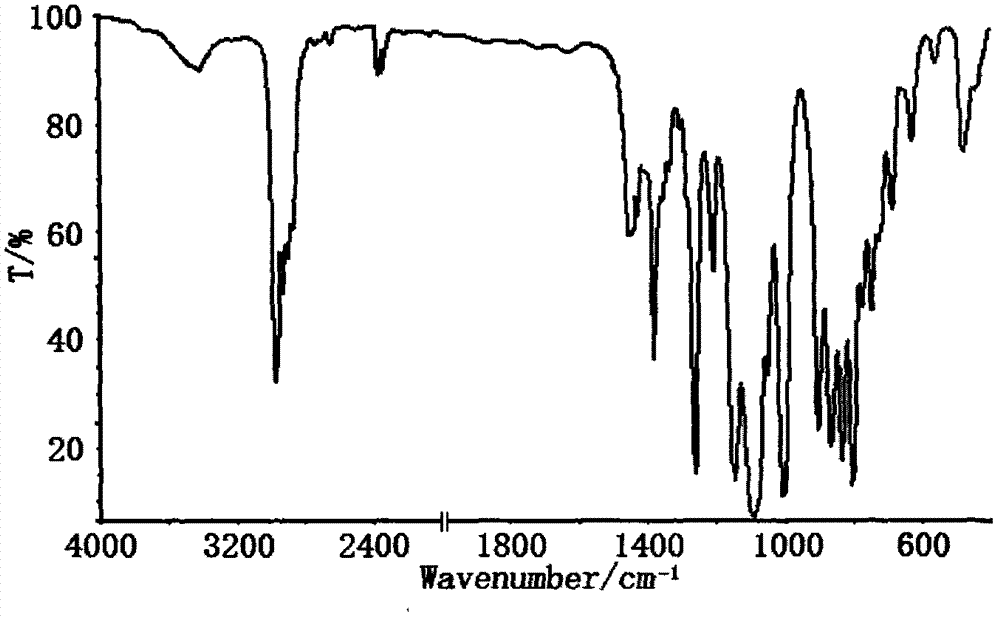Preparation method of flame retardant plasticizer dimethyl silicate di(1,3-dihaloisopropyl) ester compound
A technology of dimethyl silicic acid and flame retardant plasticizer is applied in the field of preparation of silicone and halogen synergistic flame retardant plasticizer dimethyl silicate diester compound, which can solve the limitation of use of halogen-based flame retardants, It is difficult to find alternatives and other problems to achieve the effect of good application development prospects, good symmetry, and simple equipment
- Summary
- Abstract
- Description
- Claims
- Application Information
AI Technical Summary
Problems solved by technology
Method used
Image
Examples
Embodiment 1
[0033] Example 1 In a 250ml four-necked bottle equipped with a stirrer, a thermometer and a condenser tube, and a drying tube and a hydrogen chloride absorption device at the top of the condenser tube, replace the air in the bottle with nitrogen, and add 6.45g (0.05mol ) dimethyldichlorosilane and 65ml of acetonitrile, add dropwise 21.79g (0.1mol) of 1,3-dibromoisopropanol, and control the reaction temperature at a rate not higher than 30°C. React for 8 hours; after the HCl gas is released, add 0.24g melamine, adjust the pH of the system to 5-6, filter with suction, and distill the filtrate under reduced pressure to remove the solvent and a small amount of low boiling point substances to obtain dimethyl silicate bis(1,3- Dibromoisopropyl) ester, yield 89.6%.
Embodiment 2
[0034]Example 2 In a 250ml four-necked bottle equipped with a stirrer, a thermometer and a condenser tube, and a drying tube and a hydrogen chloride absorption device at the top of the condenser tube, replace the air in the bottle with nitrogen, and add 6.45g (0.05mol ) dimethyldichlorosilane and 55ml dichloroethane, add dropwise 23.97g (0.11mol) 1,3-dibromoisopropanol, control the reaction temperature with the dropping rate not higher than 30°C, and raise the temperature to 70°C after dropping ℃, heat preservation reaction for 5h; after the HCl gas is released, add 0.49g melamine, adjust the pH of the system to 5-6, filter with suction, and distill the filtrate under reduced pressure to remove the solvent and excess 1,3-dibromoisopropanol (recycled and used ) and a small amount of low boiling point substances to obtain bis(1,3-dibromoisopropyl) dimethyl silicate with a yield of 92.2%.
Embodiment 3
[0035] Example 3 In a 250ml four-necked bottle equipped with a stirrer, a thermometer and a condenser tube, and a drying tube and a hydrogen chloride absorption device at the top of the condenser tube, replace the air in the bottle with nitrogen, and add 6.45g (0.05mol ) dimethyldichlorosilane and 40ml tetrahydrofuran, add 27.24g (0.125mol) 1,3-dibromoisopropanol dropwise, and control the reaction temperature at a rate not higher than 30°C. React for 9 hours; after the HCl gas is released, add 0.73g of melamine, adjust the pH of the system to 5-6, filter with suction, distill the filtrate under reduced pressure to remove the solvent, excess 1,3-dibromoisopropanol (recycled) and a small amount of Low-boiling point products yielded bis(1,3-dibromoisopropyl) dimethyl silicate with a yield of 90.7%.
PUM
| Property | Measurement | Unit |
|---|---|---|
| decomposition temperature | aaaaa | aaaaa |
| density | aaaaa | aaaaa |
| decomposition temperature | aaaaa | aaaaa |
Abstract
Description
Claims
Application Information
 Login to View More
Login to View More - R&D
- Intellectual Property
- Life Sciences
- Materials
- Tech Scout
- Unparalleled Data Quality
- Higher Quality Content
- 60% Fewer Hallucinations
Browse by: Latest US Patents, China's latest patents, Technical Efficacy Thesaurus, Application Domain, Technology Topic, Popular Technical Reports.
© 2025 PatSnap. All rights reserved.Legal|Privacy policy|Modern Slavery Act Transparency Statement|Sitemap|About US| Contact US: help@patsnap.com



